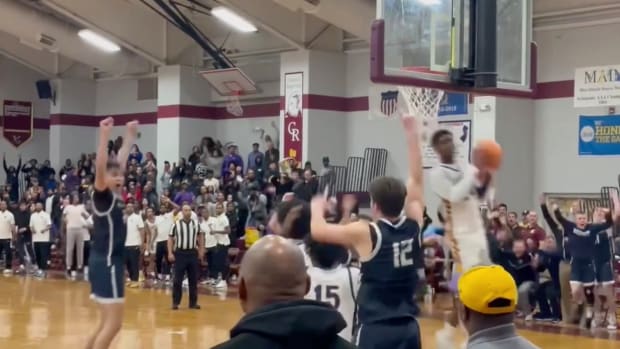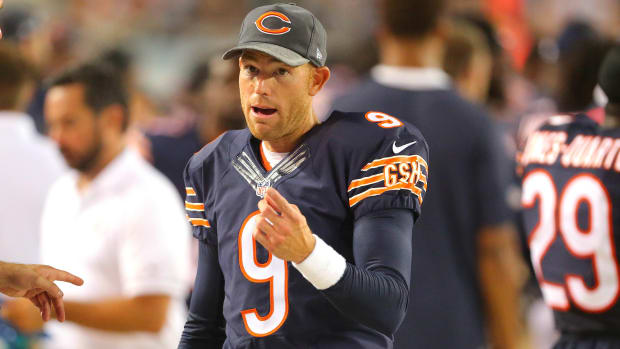Georgia is starting to challenge Big Three as football recruiting hotbed
Few people would argue that the top college football-producing states are California, Florida and Texas, in no particular order. They're the well-established recruiting hotbeds, regions that churn out blue-chip prospects with unparalleled regularity. No matter which boasts the most talent from year to year, one thing seems clear: California, Florida and Texas are in a class of their own.
Well, at least they were. A closer look at the numbers reveals that another state is quickly gaining traction as a football recruiting manufacturer. Georgia is close to expanding the Big Three to a Big Four.
"I'm not sure Georgia's getting the respect they deserve," said Loganville Grayson coach Mickey Conn. "I think we've got the best football in the country, in my opinion. We may not have as many teams as Texas and California, but we have more players than most people have any clue about."
That perception is changing. The Peach State is getting some long overdue respect.
To get a sense of which states rank just behind California, Florida and Texas, Rivals polled seven recruiting analysts to rank their next five states in order. Georgia was the unanimous pick as the No. 4 state. Ohio finished as a clear-cut fifth choice, Louisiana and Virginia tied for sixth place and Alabama came in eighth.
"The last two or three years of talent in that state has been off the hook," Rivals.com national recruiting analyst Mike Farrell said.
The numbers abet that claim. Three of the 17 five-star prospects in the class of 2013 are from Georgia: Loganville Grayson defensive end Robert Nkemdiche (No. 1), Vienna Dooly County defensive tackle Montravius Adams (No. 10) and Alpharetta Milton defensive end Carl Lawson (No. 14). Florida is the only other state with three five-star prospects.
In fact, it's part of a larger trend. Georgia high schools have produced 125 four- and five-star recruits over the last five years. By comparison, Ohio has produced 83, Louisiana 62, Alabama 60 and Pennsylvania 54.
Even more telling: Ohio had 15,000 more students playing high school football than Georgia did in 2010-11, according to the National Federation of High School Associations. Yet Georgia produced 88 more prospects rated three stars or higher than Ohio did over the last two recruiting cycles (2011 and 2012).
"When you look at the numbers, it's overwhelming in Georgia's favor," said Farrell. "But I think there was always some question. Is it Georgia? Is it Louisiana? Is it Ohio?''
There's little doubt anymore. Farrell said Georgia began to cement its claim to the No. 4 spot after its 2011 class featured eight of the nation's top 56 prospects, including Columbus Carver running back Isaiah Crowell and Thomasville Thomas County Central defensive end Ray Drew. Momentum hasn't slowed down since.
"That year propelled into last year, which propelled into this year," Farrell said. "The 2011, 2012 and now 2013 [classes] have seen such a different caliber of talent in Georgia that pushed them to my immediate answer for No. 4 now."
Consensus is growing that Georgia has risen to the No. 4 recruiting hotbed. But a bigger question is in play: Is the state ready to challenge the Big Three for football superiority?
At least one coach thinks so. Conn pointed out some recent head-to-head victories by Georgia high schools over programs in Florida and California to make his case that the Peach State deserves more attention. And he'll have additional chances this year: Grayson is scheduled to play Miami Central -- last year's Florida Class 6A runner-up -- on Aug. 31.
"You're on the right track putting us in that [No. 4] category, but I think we're as good as or better than any of the states, in my opinion," Conn said.
For now, Georgia is No. 4. Here's a rundown of all the states that received multiple votes in our survey, along with the case for and against each.
The case for: Where to begin? Georgia led all contenders in three-star recruits (452, not including players from Georgia Military College), four-star recruits (115) and five-star recruits (10) from 2008-12. If you measure Georgia's 165 FBS signees in 2012 against its 2010-11 total of 32,088 high school football players across the state, Georgia maintained the nation's second-best ratio of FBS signees per high school player; only Florida ranked higher. Georgia's total of three five-star prospects in the current Class of 2013 rankings matches Florida for the most in the nation.
The case against: Louisiana and Alabama had more NFL players per capita last season, though Georgia had a higher total overall. Georgia and Georgia Tech are also the state's only FBS programs, though Georgia State will join them in 2013.
The case for: Traditionalists point to Ohio and Pennsylvania as the biggest football-producing states after California, Florida and Texas. And while the talent level in Pennsylvania has dropped off in recent years, Ohio continues to live up to its lofty billing. Texas, Florida, California and Georgia are the only states that produced more FBS signees this year. Of the states on this list, only Georgia manufactured a higher total of four- and five-star prospects from 2008-12.
The case against: Ohio had more than double the number of high school football players as Alabama or Louisiana did in 2010-11. Still, Ohio produced less than twice as many FBS signees than either of those states.
The case for: Louisiana had the most NFL players per capita of any state last year, and counting Louisiana's number of 2012 FBS signees against its total number of high school football players in 2010-11, only Florida and Georgia recorded better ratios. Louisiana had 18,229 high school football players in 2010-11 -- lower than the totals of Pennsylvania (26,505), Virginia (25,549) or Alabama (22,833) -- yet it produced a combined 62 four- and five-star recruits from 2008-12, a higher total than any of those states.
The case against: While Louisiana's per capita totals in producing FBS players and NFL players are extremely impressive, the state's relatively low population makes it tough to seriously consider it over Georgia or Ohio, football hotbeds with more than twice as many residents.
The case for: Virginia has eight players in the 2013 Rivals100, behind only Florida (15), California (12) and Texas (10). Virginia's numbers also become even more impressive after taking into account players from prep schools Chatham Hargrave Military Academy and Fork Union Military Academy, though many of those prospects attended high schools in states other than Virginia.
The case against: Richmond Heritage linebacker Curtis Grant, who signed with Ohio State in 2011, is the only five-star prospect to come directly from a Virginia high school since 2008. Georgia had 10 five-star prospects, Alabama and Ohio had eight, Louisiana had seven and Pennsylvania had six. Also, excluding the players from Hargrave or Fork Union, Virginia produced just 142 three-star prospects from 2008-12, the lowest total of any of the states on this list.
The case for: Alabama and Auburn have combined to win the last three national championships, and more than one-third of the players that each school has signed over the last five years have been in-state products. The state's top prospects also often meet expectations. Alabama's eight five-star recruits from 2003-08 included three first-round draft picks (Julio Jones, Dre Kirkpatrick and Andre Smith), one second-round pick (Chad Jackson) and one player who's projected as a potential first-round draft pick (D.J. Fluker).
The case against: The same argument made against Louisiana also applies to Alabama. Louisiana is actually slightly smaller than Alabama, yet it manufactured more NFL players at the start of last season (53 for Louisiana, 46 for Alabama) and more combined four- and five-star recruits (62 for Louisiana, 60 for Alabama) from 2008-12.
The case for: History. Pennsylvania is the state that produced Hall of Fame quarterbacks Joe Montana, Dan Marino, Johnny Unitas, Joe Namath and Jim Kelly, as well as so many other legendary performers.
The case against: Pennsylvania's talent level isn't quite what it used to be. Pennsylvania ranks well behind each of the other states on our list in NFL players per capita. It also had the fewest four-star recruits (48) on our list from 2008-12, and ranked ahead of only Virginia in three- and five-star recruits during that span.





